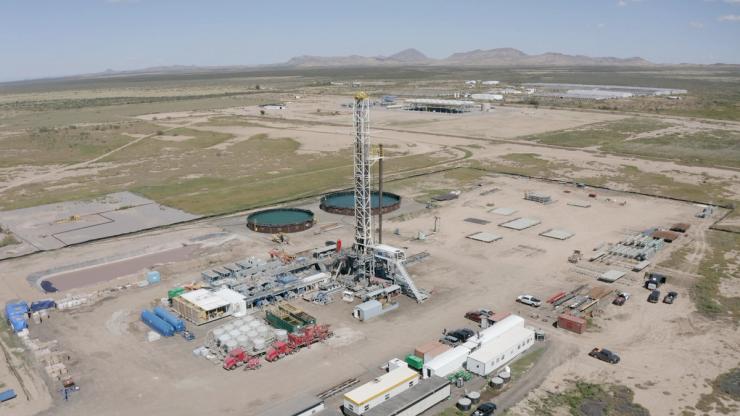The News
Seemingly every day, governments and corporations worldwide are announcing new investments into cutting-edge green energy technology, like next generation nuclear reactors or direct air capture, while massive sums are directed to tried-and-true renewable sources like solar and wind power.
The US military, by contrast, is bullish on a decades-old electricity source that has never quite hit the limelight: geothermal energy. Just last month, the Army signed a contract for one such project, while the Navy reached agreements with two additional geothermal companies. The Air Force also has a number of exploratory projects underway.
The goal is to use the clean, baseload electricity from geothermal energy to power military bases that are ultimately able to island themselves if the traditional grid goes down due to extreme weather or an adversarial attack.
Know More
Traditionally, geothermal energy has been constrained to specific geographies where heat from the Earth’s crust has bubbled close to the surface — perhaps most famously in Iceland. But no matter where you are, if you dig deep enough, you’ll hit hot rocks. Now, geothermal startups like Fervo Energy, Sage Geosystems, Eavor Technologies, and GreenFire Energy are leveraging advancements from the oil and gas industry to access heat in more areas of the world.
And the funding is pouring in: Last year, Fervo launched a first-of-its-kind project in Nevada to help power two Google data centers. In February, it raised $244 million in Series D funding, and Eavor and Sage recently raised $182 million and $17 million, respectively. All three saw their investment rounds led by oil and gas companies.
The Department of Energy is investing too, dispersing up to $60 million in grant funding for three companies pursuing an approach called Enhanced Geothermal Systems, or EGS, which involves creating geothermal reservoirs via fracking. Water then flows through the fractures and is heated by the rocks before being pumped to the surface.
But that’s not the only way to access deep heat: The military views next-generation geothermal tech as a means to greater energy security, and the Department of Defense has indicated interest in a wider array of approaches. Eavor and GreenFire use closed-loop, underground heat exchangers, which circulate fluid through pipes and pick up heat from the surrounding rock. Sage’s innovation is treating the fracture it creates “like a balloon” by storing a high volume of water in it, CEO Cindy Taff — herself an oil and gas veteran — told me. This high pressure reservoir then naturally pushes water to the surface when a valve is opened, increasing system efficiency.
Kirk Phillips, Director of the Air Force’s Office of Energy Assurance, said in an interview that the military was a logical partner to help these geothermal companies reach rapid commercialization, because it’s “innovative in a practical sense.” While the DOE may be more inclined towards funding basic research or placing long-term bets, the military is “ready to be innovative but really at the point of adoption.”
The opportunity for geothermal startups is huge. As the nation’s largest energy consumer, the DOD currently accounts for over 1% of the United States’ total electricity usage. The Army has a goal of installing a microgrid on every base by 2035, and the DOD overall aims to achieve net-zero emissions across all of its buildings, campuses, and installations by 2045.
The Air Force alone has received $7.4 million from Congress and other funding programs to conduct feasibility studies for next-gen geothermal projects, with exponentially larger contracts for full-scale plants on the horizon if the studies and pilots prove successful.
Geothermal is an attractive option for the military as most of its infrastructure is underground (and thus well protected) and it’s not dependent on an external fuel source like the diesel generators that the military has historically relied upon. Philips’ ideal would be to site geothermal on every single Air Force base. But since not every location is geologically favorable, his more modest goal “would be to have geothermal power at every installation where it’s doable to meet its critical mission needs.”
Katie’s view
Next-gen geothermal power has a few major advantages over other forms of renewable energy.
For one, its small above-ground land footprint and ability to produce clean energy 24/7 sets it apart from wind and solar, making it an ideal candidate for secure military microgrids that can operate independently. These attributes also apply to traditional geothermal, but next-gen technologies could make geothermal a feasible option for military bases across a wider variety of geographies.
It also has strong support in Congress. A combination of fracking and heavy investment from oil and gas majors would typically pose a PR problem, but the industry has found that the marriage of giant oil rigs with green energy production has in fact proven to be a winning combo. “Both sides of the legislature, they love us,” Eavor CEO John Redfern told me. “We tick all the boxes.”
In March, a bipartisan group of senators introduced a bill called the Geothermal Energy Optimization Act, which would exclude all geothermal exploration activities on public lands, such as drilling test wells, from environmental review. This would put geothermal exploration on equal footing with oil and gas exploration, with the goal of avoiding the permitting pitfalls that derail so many large energy infrastructure projects. (Some smaller hurdles along these lines have already been cleared.)
Room for Disagreement
New geothermal tech no doubt has potential, but the ultimate role it could play in the US’s electricity mix remains up for debate: Redfern and Taff say it could meet between 20% and 30% of US electricity needs, but Chetan Krishna, a cleantech expert at the Rocky Mountain Institute think tank, projects a maximum of 8% of US electricity demand, and around 5% of global demand. Krishna acknowledged, however, that the studies these numbers come from aren’t predicting significant technical or financial improvements in geothermal power, something all aforementioned startups would definitely debate. The studies also have yet to evaluate the role that closed-loop systems like Eavor’s could play in the geothermal landscape.
Like all clean power projects, widespread adoption of geothermal could be greatly hindered by massively backlogged grid interconnection queues. A 2020 RMI analysis also pointed out that geothermal is nowhere near as cheap as wind or solar power, and its consistency-of-supply advantage could be eroded by the increasing prevalence and falling costs of battery storage.
The View From Germany
Given the ongoing war in Ukraine, Germany is eager to wean itself off Russian gas. And since the country closed its last nuclear reactor last year, it has been desperate for alternate sources of carbon-free energy. So while it’s more expensive to drill in Germany, and the temperatures aren’t as favorable as the US, the country has nevertheless courted geothermal development by offering generous feed-in tariffs and high offtake prices.
“They’re offering incentives that represent the true value of the product,” said Redfern. Eavor received a €91.6 million ($99 million) grant from the European Innovation Fund to build its first commercial facility in Bavaria, Germany, which is set to run at full capacity by late 2026. Overall, Redfern says the company has around 70 potential projects in the pipeline in Germany alone.


